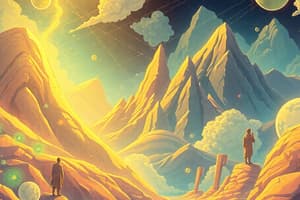Podcast
Questions and Answers
What is the primary focus of microeconomics?
What is the primary focus of microeconomics?
- Examination of overall economic trends
- Understanding government fiscal policies
- Study of individual markets and businesses (correct)
- Analysis of global trade policies
Which best describes opportunity cost?
Which best describes opportunity cost?
- The value of the next best alternative forgone (correct)
- The total cost of all available options
- The cost of resources used for a choice
- The profit gained from a chosen option
What does market equilibrium indicate?
What does market equilibrium indicate?
- Quantity supplied equals quantity demanded (correct)
- Surplus is being generated
- Prices are rising uncontrollably
- Government intervention is required
Which factor does NOT affect supply?
Which factor does NOT affect supply?
How does an increase in consumer income generally affect demand?
How does an increase in consumer income generally affect demand?
Which of the following occurs when there is a surplus in the market?
Which of the following occurs when there is a surplus in the market?
What role does technology play in supply?
What role does technology play in supply?
Which of these best influences consumer demand?
Which of these best influences consumer demand?
What type of economy is characterized by government control over production decisions?
What type of economy is characterized by government control over production decisions?
What does the Production Possibility Curve (PPC) illustrate?
What does the Production Possibility Curve (PPC) illustrate?
Which economic system emphasizes private ownership and market-based decisions?
Which economic system emphasizes private ownership and market-based decisions?
What is the primary focus of economic development?
What is the primary focus of economic development?
Which factor is primarily associated with economic growth?
Which factor is primarily associated with economic growth?
What does unemployment specifically refer to?
What does unemployment specifically refer to?
In a mixed economy, what role does the government play?
In a mixed economy, what role does the government play?
What does inflation represent in an economy?
What does inflation represent in an economy?
Which of the following does the Circular Flow of Income model demonstrate?
Which of the following does the Circular Flow of Income model demonstrate?
What basic economic problem involves deciding what goods and services to produce?
What basic economic problem involves deciding what goods and services to produce?
Flashcards
Traditional Economy
Traditional Economy
Economic decisions based on customs, traditions, and beliefs.
Command Economy
Command Economy
The government controls production and makes economic decisions.
Market Economy
Market Economy
Individuals and businesses make decisions based on supply and demand.
Mixed Economy
Mixed Economy
Signup and view all the flashcards
Production Possibility Curve (PPC)
Production Possibility Curve (PPC)
Signup and view all the flashcards
Basic Economic Problems
Basic Economic Problems
Signup and view all the flashcards
Inflation
Inflation
Signup and view all the flashcards
Unemployment
Unemployment
Signup and view all the flashcards
Circular Flow of Income
Circular Flow of Income
Signup and view all the flashcards
Economic Development
Economic Development
Signup and view all the flashcards
Economics
Economics
Signup and view all the flashcards
Microeconomics
Microeconomics
Signup and view all the flashcards
Macroeconomics
Macroeconomics
Signup and view all the flashcards
Scarcity
Scarcity
Signup and view all the flashcards
Opportunity Cost
Opportunity Cost
Signup and view all the flashcards
Supply and Demand
Supply and Demand
Signup and view all the flashcards
Market Equilibrium
Market Equilibrium
Signup and view all the flashcards
Factors Affecting Demand
Factors Affecting Demand
Signup and view all the flashcards
Study Notes
Introduction to Economics
- Economics studies how societies allocate scarce resources to meet unlimited wants and needs.
- It analyzes choices made by individuals, businesses, and governments.
- Microeconomics examines individual markets and businesses, while macroeconomics studies the entire economy.
- Key economic concepts include scarcity, opportunity cost, supply and demand, and market equilibrium.
Scarcity
- Resources are limited, while wants and needs are unlimited.
- Scarcity drives economic decision-making.
- Scarcity necessitates choices and trade-offs.
Opportunity Cost
- Opportunity cost is the value of the next best alternative forgone.
- It measures the relative cost of a decision.
- Every choice has an opportunity cost.
Supply and Demand
- Supply is the quantity of a good or service producers are willing to offer at various prices.
- Demand is the quantity of a good or service consumers are willing to purchase at various prices.
- Supply and demand interactions determine market prices and quantities.
Market Equilibrium
- Market equilibrium occurs when quantity supplied equals quantity demanded.
- At equilibrium, there's no pressure for prices to change.
- Any surplus or shortage leads to price adjustments until equilibrium is restored.
Factors Affecting Supply
- Input costs (raw materials, labor, capital) affect production costs and supply.
- Technology improvements increase productivity and lower costs, boosting supply.
- Government regulations (taxes, subsidies) affect production costs and supply.
- Producer expectations influence current supply decisions.
- The number of sellers impacts the overall supply.
Factors Affecting Demand
- Consumer tastes and preferences shift demand.
- Consumer income impacts purchasing power and demand.
- Related good prices (complements and substitutes) influence demand.
- Consumer expectations about future prices or conditions affect current demand.
- The number of buyers affects overall demand.
Types of Economies
- Traditional Economy: Decisions based on customs, traditions, and beliefs.
- Command Economy: The government controls production (what, how, and for whom).
- Market Economy: Decisions made by individuals and businesses based on supply and demand.
- Mixed Economy: Combines elements of command and market economies, with government regulation and market freedom.
Production Possibility Curve (PPC)
- PPC illustrates trade-offs between producing two goods with limited resources and technology.
- It shows the maximum possible output combinations.
- Points outside the curve are currently unattainable.
Basic Economic Problems
- What to produce?: Determining goods and services based on consumer needs and desires.
- How to produce?: Choosing production methods and resources.
- For whom to produce?: Deciding who receives the produced goods and services.
Basic Economic Systems
- Capitalism: Private ownership, market decisions, and profit motive.
- Socialism: Government ownership controls major resources for social welfare and equality.
- Communism: Theoretical system with common ownership and classless society, often manifested in practice as a totalitarian state.
Circular Flow of Income
- Shows the continuous flow of money, goods, and services between households and firms.
- Firms produce, sell to households, receive payment, and households provide factors and earn income.
Economic Growth
- Increases in a nation's productive capacity (measured by real GDP per capita) over time.
- Driven by technological advancements, capital accumulation, and labor force growth.
- A common economic goal.
Economic Development
- Focuses on improving economic well-being through factors like education, healthcare, and infrastructure, alongside growth.
Inflation
- A sustained increase in the general price level of goods and services.
Unemployment
- People actively seeking jobs but unable to find work. Types include frictional, structural, and cyclical unemployment.
Government Role in the Economy
- Regulate and stabilize the economy.
- Provide public services.
- Address market failures (e.g., monopolies and externalities).
Studying That Suits You
Use AI to generate personalized quizzes and flashcards to suit your learning preferences.




